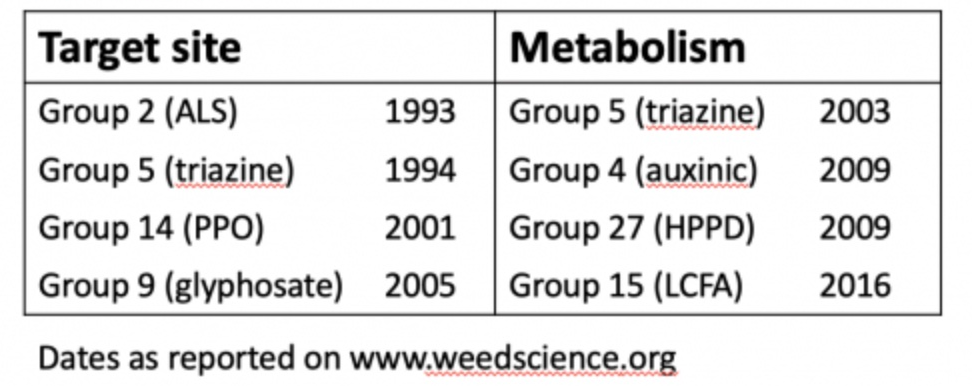Understanding Metabolic Resistance

When a weed scientist says a novel weed resistance issue is not well understood, it’s a little concerning.
Most farmers understand the need to apply multiple herbicide groups and rotate them to reduce the number of herbicide-resistant weeds going to seed. This practice reduces target-site weed resistance when a weed alters its genetic code so the chemical no longer fits the protein it was designed to attack.
However, some weeds are evolving to deploy suites of enzymes that work together to metabolize (detoxify) a chemical before it can kill a weed—known as non-target or metabolic resistance.
“Ten or 15 years ago, we weren’t seeing much metabolic resistance in waterhemp, as it was all target-site resistance,” says Pat Tranel, University of Illinois weed scientist and associate head of the Department of Crop Sciences.
“Today, I’d estimate more than half of our waterhemp in Illinois has glyphosate resistance [target-site], and 50% have atrazine resistance [metabolic/non-target]. Approximately 10% of the waterhemp population has HPPD resistance which is all metabolic,” Tranel says. He suspects there’s more metabolic resistance than we realize in preemergence Group 15 herbicides because reduced residual control by a few weeks makes it difficult to pinpoint whether it’s resistance or weather-related.

Known resistance mechanisms in waterhemp and date they were first reported
At a molecular level, scientists can easily determine target-site resistance because they know the protein and can look directly at the genetic code of waterhemp to determine the responsible mutation. But for non-target metabolic resistance, it’s still a guessing game. Researchers can sometimes identify an enzyme class that detoxifies a chemical but know little about which genes code for those enzymes.
Tranel and his colleagues have determined that waterhemp has evolved resistance to seven different herbicide groups, and all have some metabolic resistance. “Our research focuses on what enzymes or genes are involved, what is selecting for those enzymes, and why the same mechanism can confer resistance to other herbicide groups. Until we understand all this, we’re at a loss to make herbicide recommendations for metabolic resistance,” he says.
Tranel uses Enlist® crops to explain metabolic resistance. The same gene used to confer 2,4-D resistance in Enlist corn or soybeans can also metabolize the Group 1 ‘FOP’ herbicides like quizalofop. “The reason for this is an unpredictable cross-resistance that we talk about in weeds,” he says.
There’s some similarity around the chemicals of those herbicide molecules, allowing them to be recognized by the same metabolizing enzyme. This process is similar in weeds. “If a weed gets selected for an enzyme that can metabolize herbicide A that the farmer has used, it’s also possible that same enzyme can metabolize herbicide B,” Tranel says.
The metabolic resistance process gets further complicated over time. Weed scientists worry about weed populations that receive different herbicides over many seasons will lead to numerous enzymes metabolizing numerous herbicide groups. In other words, the herbicides select for suites of enzymes that can collectively work together to metabolize different herbicides.
“It’s not an exaggeration that we are selecting weed populations that can metabolize herbicides that have not even been commercialized yet,” Tranel says.
Even when research narrows down the genes responsible for metabolic resistance, growers still need to worry about target-site resistance. Using multiple effective sites of action and rotating herbicides using a three- to four-year plan is essential to manage target-site resistance.
“But just doing this alone will not prevent metabolic resistance,” stresses Tranel. “Farmers need to know they cannot beat weed resistance with herbicides. Non-chemical strategies are needed to manage weeds. The overriding goal should always be no weeds going to seed.”
Will farmers reach a point where mechanical weed seed destruction technology on combines becomes mainstream, like in Australia, where they’ve dealt with metabolic weed resistance since the 1980s? Tranel thinks it’s certainly a possibility.
“Weed seed destruction technology has a fit, but with limitations as it works better in some crops than others,” he says. “Weeds will adapt, as I can predict waterhemp will start shattering seeds before combines roll. We preach diversity in strategies, as the more things you throw at weeds, it’s harder for them to adapt.”
Content provided by DTN/Progressive Farmer.
Find expert insights on agronomics, crop protection, farm operations and more.